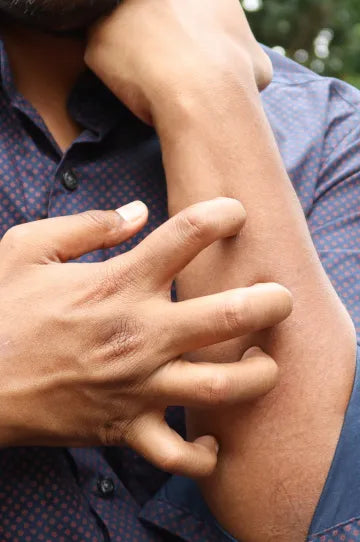




What are you looking for?

Ayurvedic medicine for allergy relief—learn gentle herbs, diet tips, and routines that may ease sneezing, eczema, itching, and rashes. Clear, step-by-step guide.



Season change, dust, or certain foods can make the nose run, skin itch, or rashes flare. Many people look to ayurvedic medicine for allergy support because it focuses on balance—of diet, routine, and gentle herbs. This guide keeps it simple. You’ll learn what usually triggers symptoms, how Ayurveda views them, and small steps that may help at home. Use it as a starting point, then speak to a qualified practitioner for personal care.
In simple words, your body is reacting to a trigger like pollen, dust, or a food. Ayurveda explains this as an imbalance in doshas—often pitta (heat/inflammation) and kapha (mucus/heaviness). When agni (digestive fire) is weak and ama (toxins) builds up, the body becomes extra reactive. Support digestion, lower heat, and clear heaviness; symptoms may settle.
Ayurveda uses time-tested plants that are cooling, soothing, or immune-supportive. Always do a patch test for skin use and take herbs under guidance if you’re pregnant, nursing, or on medication.

Tip: Use single-herb approaches first. See how your body responds before mixing many herbs.
Small, steady changes work best.
Ayurveda sees eczema (often called vicharchika) as a pitta-kapha issue with ama. Focus is on cooling the system, restoring the skin barrier, and regular digestion.

Our doctor-formulated blends use Complex Plant Elixir™—synergistic botanicals chosen to support skin balance—and Bio-Neuromodulation™, which means supporting calm nerve communication so the “itch–scratch” cycle may ease. These concepts guide gentle, long-term care alongside your routine and diet.
A1: Begin with food and routine: turmeric in cooking, warm water, and light meals. For herbs, many people start with guduchi or tulsi. Add only one change at a time and watch your response.
Cooling, skin-friendly options include turmeric, manjistha, aloe, and coconut oil. Keep the skin barrier moist, cut high-heat foods, and track triggers. See a practitioner for personalised dosing.
Use only gentle moisturisers (aloe/coconut) and food changes after discussing with a paediatrician or qualified Ayurvedic doctor. Avoid strong herbs and essential oils on young skin.
Simple changes may ease symptoms in 2–3 weeks, but chronic eczema can take longer. Stay steady with diet and sleep, and check with a professional for a tailored plan.
Natural does not always mean risk-free. Neem and licorice have caveats; giloy may interact with some conditions. Patch test skin applications and speak to your doctor if you take medicines or are pregnant.
If your skin flares with heat and spots, our Acne SOS is crafted with a Complex Plant Elixir™ to support calm, clear skin. It layers well with a simple aloe or coconut base and everyday spice changes in your meals.
If digestion or night-time itching is a trigger, explore Gut Reset for gentle digestive balance and Tranquil Tonic to support restful sleep. Use them with your practitioner’s advice and a steady routine.
You can also search for: Ayurvedic Medicine For Acidity And Gas | Ayurvedic Medicine For Acidity Safe Gas Relief | Ayurvedic Medicine For Anxiety And Stress Calm The Mind Sleep Better | Ayurvedic Medicine For Cholesterol Natural Control Guide | Ayurvedic Medicine For Constipation | Ayurvedic Medicine For Constipation Simple Relief | Ayurvedic Medicine For Dry Cough Natural Relief By Amiy Naturals | Ayurvedic Medicine For Headache Gentle Lasting Relief | Ayurvedic Medicine For Hormonal Imbalance Women S Guide | Ayurvedic Medicine For Hormonal Imbalance Women S Guide 1 | Ayurvedic Medicine For Inflammation And Pain Natural Relief | Ayurvedic Medicine For Irregular Periods Gentle Relief Balance | Ayurvedic Medicine For Joint Muscle Pain Simple Relief | Ayurvedic Medicine For Knee Pain Natural Relief Guide | Ayurvedic Medicine For Nerve Pain Natural Relief Guide | Ayurvedic Medicine For Pimples Clear Skin Naturally | Ayurvedic Medicine For Sleep Gentle Ways To Rest | Ayurvedic Medicine For Stomach Pain Gentle Relief | Ayurvedic Medicine For Weight Gain Safe Natural Ways | Ayurvedic Medicine Joint Muscle Pain | Ayurvedic Medicine Simple Guide To Natural Healing | Ayurvedic Solution For Stress Anxiety Amiy Naturals | Ayurvedic Syrup For Irregular Periods Gentle Cycle Support | Best Ayurvedic Health Supplements Amiy Naturals Online | Best Ayurvedic Medicine For Acidity And Gas | Best Ayurvedic Medicine For Blood Circulation Amiy Muscle Mercy 1 | Best Ayurvedic Medicine For Body Pain And Weakness Natural Relief | Best Ayurvedic Medicine For Gastric Problem Simple Relief | Best Ayurvedic Medicine For Insomnia Anxiety Amiy Naturals | Best Ayurvedic Medicine For Insomnia Anxiety Amiy Naturals 1 | Best Ayurvedic Medicine For Insomnia Sleep Drops By Amiy | Best Ayurvedic Medicine For Memory And Concentration | Best Ayurvedic Medicine For Migraine Gentle Relief | Best Ayurvedic Medicine For Neurological | Best Ayurvedic Medicine For Painful Menstruation Amiy Naturals | Best Ayurvedic Medicine For Sinus Allergy Relief | Best Ayurvedic Medicine For Skin Diseases Amiy Naturals | Best Ayurvedic Medicine For Snoring Problems Natural Relief | Best Ayurvedic Medicine For Stamina Energy | Best Ayurvedic Medicine For Stomach Cleansing Drops | Best Ayurvedic Medicine For Stomach Problems | Best Ayurvedic Medicine For Varicose Veins Relief | Best Ayurvedic Medicine For Women S Health Amiy Naturals Drops | Best Ayurvedic Medicine For Women S Health Amiy Naturals Drops 1 | Best Ayurvedic Oil For Muscle Pain Relief Safe Natural Support | Best Ayurvedic Products For Skin Herbal Medicine Onlin 1 | Best Ayurvedic Skin Care Products Clear Calm Glowing | Best Ayurvedic Skin Care Products Simple Picks For Clear Calm Skin | Best Ayurvedic Syrup For Glowing Clear Skin Amiy Naturals | Best Medicine For Nerve Pain In Neck Ayurvedic Guide | Buy Ashwagandha Ayurveda Drops Stress Relief Energy Boost | Buy Ayurvedic Blood Purifier Natural Herbal Drops For Healthy Blood | Buy Best Ayurvedic Medicine For Memory Concentration Amiy Naturals | Buy Best Ayurvedic Tonic For Glowing Skin Amiy Naturals | Top 10 Ayurvedic Herbs For Daily Use | Weight Loss Ayurvedic Medicine Safe Options For Women